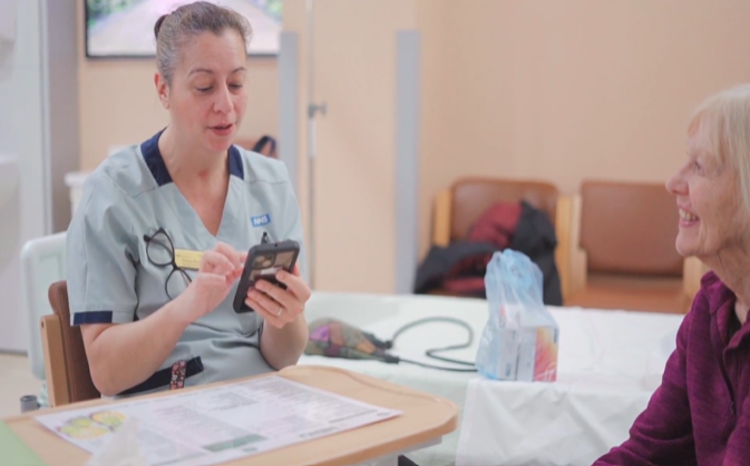Somerset A&E clinicians benefit from electronic patient record
- 18 July 2017

Somerset clinicians providing frontline emergency care now have instant access to GP medical records of half a million patients in the county.
More than 500 urgent and emergency care staff working across A&E and other acute medical units in Somerset are using the EMIS Web EPR Viewer, to view crucial information in patients’ GP medical records.
Musgrove Park Hospital A&E clinician Philip Rowburrey said he finds that access to EMIS EPR Viewer saves a lot of time, particularly out of hours.
“I also check a patient’s recent consultations to try and establish if their presenting complaint is acute or something that has previously been investigated by primary care”, Rowburrey said. “It is becoming a ‘must check’ when we see a patient now and I thoroughly recommend that this continues.”
With patient consent, the viewer gives clinicians 24-hour real-time access to primary care records held by GPs, allowing them to securely access information which helps identify current patient medications and allergies, reduce unnecessary emergency admissions and avoid duplicate tests.
Previously, urgent or emergency care clinicians relied on contacting GP practices directly to obtain this information, or made clinical decisions based on the patient’s presenting condition and information from the patient.
[themify_box icon=”info” color=”gray”]
Uses and benefits include:
- Prompt diagnosis
- Improved patient safety and quality of experience
- Reduced hospital stay
- Avoiding unnecessary tests, for example, blood tests already carried out
- Checking patient history to ensure proposed treatments and tests are appropriate
- Checking previous referrals and appointments
[/themify_box]
The EMIS Web EPR Viewer is already being used on average 45 times per day in Somerset, about 11,000 times since the original go live date.
Before the viewer was deployed, information sharing agreements were established with the 69 EMIS Web GP practices in Somerset.
EMIS Web EPR Viewer provides a read-only view, requires patient consent at the point of care and records in a clear audit trail who has viewed any patient’s primary care record.
Richard Greaves, the Somerset Integrated Digital electronic Record (SIDeR) interoperability programme manager for Somerset CCG said: “It is best practice for clinicians to check a patient’s medical history, but it is not always something that is easy for them to do, the EMIS EPR Viewer simplifies that process dramatically.”
The initiative’s initial success has already led to plans to roll out the viewer to all clinically-led and clinically-regulated services within Somerset from summer 2017. This includes other care providers such as hospices and those based just over the county borders. It could eventually be available to more than 2,000 clinicians.






19 Comments
For information, EMIS Viewer contains a care record summary (including problems, medication, allergies, alerts, recent activity, appointments and health status), investigations, history, attachments (discharge summaries, care plans and clinic letters from secondary care), referrals and warnings. If locally supported, EMIS Viewer can also display consultation notes (free text). IMS Maxims is the main system now used in A&E in Musgrove. Jon Tipping is now Clinical Director for A&E in Yeovil District Hospital NHS Foundation Trust. SCR remains in use, for patients who are not Somerset residents.
As Clare states (above) clinicians in Musgrove Park Hospital A&E Department have been viewing SCR for some years. I know that Dr John Tipping, one of the consultants in Musgrove Park Hospital has been happy to be quoted talking about the benefits to patient care of having access to SCRs.
SCRs are updated from the GP record in real time, so are as up-to-date as the EMIS Web records viewed through the EMIS EPR Viewer. SCRs contain information about Medications, Allergies and Adverse reactions and can be enriched with Additional Information, with explicit patient consent, or with a ‘best interest’ decision for patients who lack capacity. The Additional Information can include details of past illnesses and procedures, Immunisations, Advance Care Plans and Patient Preferences and, where applicable, End of Life Care information.
The EMIS EPR viewer obviously acts as a portal for access to GP patient information on EMIS Web systems in local GP surgeries and is subject to local information sharing agreements between each practice and the hospital. But, the A&E is using Symphony (previously Ascribe but now EMIS), which can also provide integrated SCR viewing provided the ‘bolt-on’ SCR viewing module has also been purchased. Does the EMIS EPR viewer has the ability to view SCRs, which would allow access to GP records for patients from anywhere in the country (agnostic of host GP System), without the need for Information Sharing Agreements?
Fair point Clare, SCR has been used in ED in Somerset for some years, although I suspect not as widely used or referred to as often as many would imagine. EMIS Viewer delivers more and is up to date.
Thank you for your comments Ian. The first step to true interoperability is to build confidence to share information between different care organisations, even in read only form. EMIS Viewer is the first step for Somerset, which has created the appetite to connect all of the other care systems together, using FHIR to publish information externally. We are looking to create a patient context links from local clinical / care systems to a common presentation layer which will present FHIR based information from outside of each provider’s native clinical / care system. Once in place and confidence / familiarity grows, we will consider write capability too, back into the local native clinical / care systems.
A little confused by your reference to fhir publishing.
A FHIR Api allows data to be retrieved either externally, your internal viewer, mobile app etc. A supplier is only building one api, data isn’t being stored in secondary storage (data warehouse)
Going directly to FHIR would have prevented a lot of duplicated development work. Several EPR/PAS suppliers are converting their existing FHIR systems for U.K. Use. Also primary care suppliers are also working on CareConnect FHIR api’s.
I find it difficult to believe that they call this interoperability! All they are creating is just larger silos with no true interoperability at all. Vendor specific software is not the cost effective solution to information healthcare exchange. For those who are interested Lpres are using an IHE solution by Tiani-Spirit which means they can connect councils, social services, social care, education and anyone else regardless of which system they employ. Publish and consume models with strict IG and Security must be the way forward
I understand that Taunton and Somerset NHS Trust have been using the summary care record (SCR) in the ED for a number of years. While no doubt there is additional value in ED clinicians seeing the full GP record, it’s interesting that the article makes no mention of SCR.
Magnificent and certainly the way forward, but care must be taken for this system not to become, mechanic, impersonal and without human contact between symptom summary and patient.
Would this extension be within the same viewer or another application. Similarly if the patient is with a non EMIS practice, do you see their records?
Agreed, the conversation with the patient (and their consent to view their primary care record) remains vital.
There are similar solutions for non-EMIS Practices, but in Somerset 69 of 71 Practices use EMIS, and all Practices will be on EMIS before the end of this calendar year. For this reason, we have solely focussed on EMIS Viewer for Somerset residents and will continue to access SCR for non-residents.
Thank you for your comments. Read-only access to primary care records (as the richest vein of patient data) is the first step in the Somerset Interoperability build; EMIS Viewer provides a key part of the foundations. Our next step is to incrementally build opportunities for countywide access to acute, community, mental health and social care information, irrespective of care setting. Once in place, we will extend to other care providers including hospices, other registered care charities, care homes and the voluntary care sector, as well as link in with other initiatives over the county boundary, so that Somerset residents are supported elsewhere too. We will harness and apply open standards, such as FHIR, to enable sharing of care information for the purposes of direct patient care. It goes without saying, but to do this, we need time, to consult with the Somerset population; to invest appropriately; to build open standards information exchange and a universal presentation layer, linked in patient context to our existing local care systems and patient records. The fundamentals are thankfully already in place, the will and determination to share for direct patient care and local governance to guide the interoperability programme.
well done Somerset clinicians…
What is so striking for me about this story is the fact that it is news at all !
In 2017, the idea that A&E doctors can see patients GP records make perfect sense. That we continue to insist on a distinction between primary and secondary care (in terms of records and systems) shows just how far we have to go before we can properly say we have an integrated system.
I’m sure many clinicians up and down the country will read this with envious eyes….
Thank you Richard.
The front line clinicians access EMIS Web records via EMIS Viewer as a standalone read-only application, loaded directly onto their clinical PC. It is accessed directly and set up independently of each Trust EPR system. It is possible to do the latter, via an alternative EMIS product called EMIS Care Record Viewer (CRV) but that contains a reduced data set in comparison to EMIS Viewer. Somerset CCG invested in EMIS Viewer, on behalf of all Somerset Trusts, as it can display, in read-only form, all patient information (including correspondence) stored in EMIS Web. We did however make a decision locally to exclude the free text element of the patient’s primary care record.
It appears from this that it is a separate product provided by EMIS themselves:
https://www.emishealth.com/products/epr-viewer/
I had thought that this is effectively a viewer directly into EMIS data which can be accessed by external organisations. There are similar tools for RiO and various other systems. However I may be wrong here.
The main problem with supplier based portals like this is that they only work if you interact with an economy based on that suppliers system. In smaller local areas this is probably OK but locally we have a pretty diverse mix of systems and having loads of portals is not attractive.
The EMIS EPR Viewer if the front end application that A&E use (within their Symphony EPR I presume), to view the data.
A&Es do not directly “connect” to EMIS Web – there has to be a gateway mechanism, such as the MIG, Black Pear etc
Organisations do not have access to the full GP record, rather a defined “dataset”, agreed between the GP surgeries and the relevant organisation, customised if appropriate for A&E, GP OOH, palliative care (hospice) etc
Does this use Healthcare Gateway’s MIG?
No I think from the article it is going to direct to EMIS using the ‘EMIS Web EPR Viewer’ so does not require the MIG. As a result it probably give a more detailed view than the ‘ten tabs’ you get from the MIG.
Of course it’s only any good if all your local GPs use EMIS which presumably they do in this area.
Comments are closed.